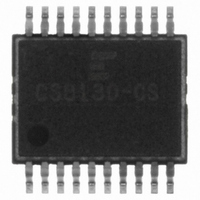CS8130-CS Cirrus Logic Inc, CS8130-CS Datasheet - Page 26

CS8130-CS
Manufacturer Part Number
CS8130-CS
Description
IC IR TRANSCEIVER 2-5V 20-SSOP
Manufacturer
Cirrus Logic Inc
Type
Transceiverr
Datasheet
1.CS8130-CS.pdf
(28 pages)
Specifications of CS8130-CS
Mounting Type
Surface Mount
Voltage - Supply
2.7 V ~ 5.5 V
Package / Case
20-SSOP
Logic Case Style
SSOP
No. Of Pins
20
Peak Reflow Compatible (260 C)
No
Supply Voltage Max
5.5V
Transceiver Type
Infrared
Driver Case Style
SSOP
Leaded Process Compatible
No
Lead Free Status / RoHS Status
Contains lead / RoHS non-compliant
For Use With
598-1161 - BOARD EVAL FOR CS8130
Number Of Drivers/receivers
-
Protocol
-
Lead Free Status / RoHS Status
Contains lead / RoHS non-compliant, Contains lead / RoHS non-compliant
Other names
598-1203-5
Available stocks
Company
Part Number
Manufacturer
Quantity
Price
Part Number:
CS8130-CSZ
Manufacturer:
CIRRUS
Quantity:
20 000
Digital Pins
RXD - Receiver Data Output
TXD - Transmit Data Input
D/C - Data/Control Mode Input
FORM/BSY - Received Data Format Output/Busy Signal Output
PWRDN - Power Down Control Input
RESET - Reset Input
XTALIN, XTALOUT - Crystal Connections
EXTCLK - External Clock Input or Output
CLKFR - Clock Frequency Select Input
26
26
Receiver output data. Normally connected to RxD on the UART.
Transmitter input data. Normally connected to TxD on the UART.
The D/C pin determines whether the input data on TXD is treated as data to be transmitted via
the LED, or as control information to set up the CS8130 internal registers. The D/C pin also
can act as a power down control.
If auto format detect mode is enabled, this pin indicates the format of the incoming data.
FORM is low for ASK format data, and high for IRDA/HPSIR format data.
In TV remote data mode (Mode 3), this pin becomes a handshake signal to the UART.
FORM/BSY low means OK to send a character. FORM/BSY high means "I am busy, do not
send another character".
PWRDN low places the CS8130 into a very low power consumption "off" state.
RESET low places all the internal logic into a known state. All the control register bits are
forced high or low, as defined in the register definition section. If the crystal oscillator is in use,
then RESET must be held low for >25 ms, with PWRDN high and power applied. If an
external clock is used, then the RESET pulse can be short (>1 s).
To use the internal oscillator, connect either a 3.6864 MHz or a 1.8432 MHz crystal between
XTALOUT and XTALIN. If using an external clock, connect XTALIN to DGND.
If no crystal is present on XTALIN and XTALOUT, EXTCLK becomes an input. A
3.6864 MHz or 1.8432 MHz clock should be connected to EXTCLK. XTALIN should be
connected to DGND.
If a crystal is present on XTALIN and XTALOUT, EXTCLK becomes an output. EXTCLK will
output the same frequency as the crystal. The EXTCLK output driver may be disabled to
conserve power.
Tie CLKFR to ground to select a 3.6864 MHz clock. Connect CLKFR to the VD+ pin to select
a 1.8432 MHz clock.
CS8130
CS8130
DS134PP2
DS134F1















